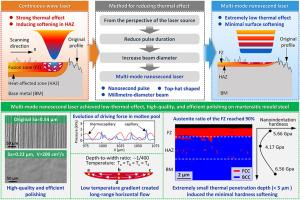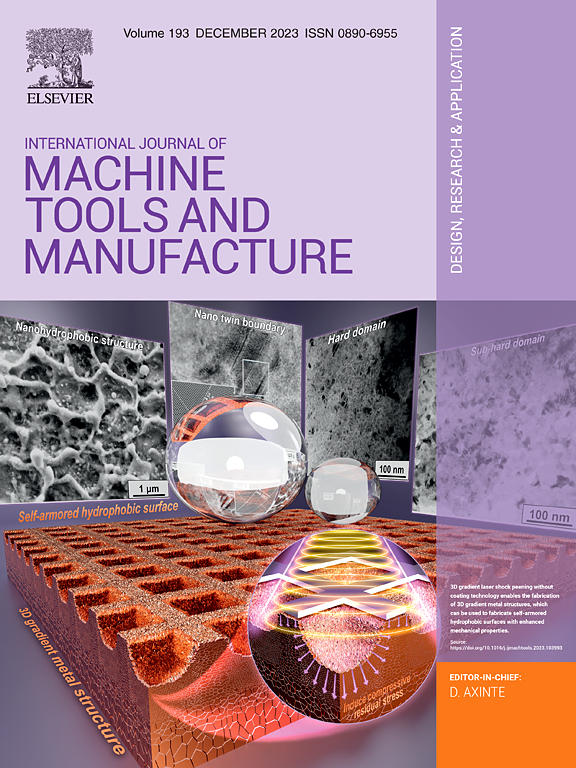Understanding the surface polishability and hardness-softening mechanisms of martensitic mould steel in multi-mode nanosecond laser polishing
IF 18.8
1区 工程技术
Q1 ENGINEERING, MANUFACTURING
International Journal of Machine Tools & Manufacture
Pub Date : 2025-07-25
DOI:10.1016/j.ijmachtools.2025.104311
引用次数: 0
Abstract
Laser polishing is an efficient, reliable, and environmentally friendly surface-finishing technique aimed at improving the surface quality. However, its application to martensitic mould steel is limited by surface-softening issues induced by the pronounced thermal effects of conventional continuous-wave laser polishing. This study proposes a multi-mode nanosecond laser polishing approach that employs a millimetre-diameter beam with top-hat energy distribution to mitigate the thermal effects and alleviate surface softening. A key challenge is achieving high-quality polishing at shallow melting depths. Further, the proposed process may alter the surface-softening mechanism when considering the unique phase-transformation behaviour of martensitic mould steel. To clarify these aspects, the characteristics of multi-mode nanosecond laser polishing, related to the process and properties, are investigated via finite-element simulations and experiments. The results demonstrate that, unlike the multi-directional melt flow induced by the intense melt pool reaction in continuous-wave laser polishing, multi-mode nanosecond laser polishing drives long-range horizontal melt flow and simultaneously induces multiple convex peaks to fill concave valleys, thereby achieving high-quality surface smoothing (Sa = 0.23 μm) with a minimal melting depth (<2 μm). Moreover, a novel surface-softening mechanism involving the synergistic induction of residual austenite enrichment (up to 90 %) in the fusion zone and martensite tempering effects in the heat-affected zone is presented, which contrasts with the traditional mechanism that relies solely on tempering-induced softening in the heat-affected zone. This study presents a low-thermal-effect, high-quality, and high-efficiency polishing solution for metal components, while advancing the theoretical understanding of hardness-softening mechanisms in the laser manufacturing of martensitic steel.

了解马氏体模具钢在多模纳秒激光抛光中的表面可抛光性和硬度软化机理
激光抛光是一种高效、可靠、环保的表面处理技术,旨在提高表面质量。然而,由于传统连续波激光抛光的明显热效应导致表面软化,限制了其在马氏体模型钢上的应用。本研究提出了一种多模纳秒激光抛光方法,该方法采用直径为毫米的能量顶帽分布光束来减轻热效应和表面软化。一个关键的挑战是在较浅的熔化深度实现高质量的抛光。此外,考虑到马氏体模具钢独特的相变行为,所提出的工艺可能会改变表面软化机制。为了阐明这些方面,通过有限元模拟和实验研究了多模纳秒激光抛光的工艺和性能特征。结果表明,与连续波激光抛光中强烈熔池反应引起的多向熔体流动不同,多模纳秒激光抛光驱动长距离水平熔体流动,同时诱导多个凸峰填充凹谷,从而以最小的熔化深度(<2 μm)实现高质量的表面光滑(Sa = 0.23 μm)。此外,提出了一种新的表面软化机制,该机制涉及熔合区残余奥氏体富集(高达90%)和热影响区马氏体回火效应的协同诱导,这与传统的仅依赖回火诱导热影响区的软化机制形成了对比。本研究提出了一种低热效应、高质量、高效率的金属零件抛光解决方案,同时推进了对马氏体钢激光加工硬度-软化机理的理论认识。
本文章由计算机程序翻译,如有差异,请以英文原文为准。
求助全文
约1分钟内获得全文
求助全文
来源期刊
CiteScore
25.70
自引率
10.00%
发文量
66
审稿时长
18 days
期刊介绍:
The International Journal of Machine Tools and Manufacture is dedicated to advancing scientific comprehension of the fundamental mechanics involved in processes and machines utilized in the manufacturing of engineering components. While the primary focus is on metals, the journal also explores applications in composites, ceramics, and other structural or functional materials. The coverage includes a diverse range of topics:
- Essential mechanics of processes involving material removal, accretion, and deformation, encompassing solid, semi-solid, or particulate forms.
- Significant scientific advancements in existing or new processes and machines.
- In-depth characterization of workpiece materials (structure/surfaces) through advanced techniques (e.g., SEM, EDS, TEM, EBSD, AES, Raman spectroscopy) to unveil new phenomenological aspects governing manufacturing processes.
- Tool design, utilization, and comprehensive studies of failure mechanisms.
- Innovative concepts of machine tools, fixtures, and tool holders supported by modeling and demonstrations relevant to manufacturing processes within the journal's scope.
- Novel scientific contributions exploring interactions between the machine tool, control system, software design, and processes.
- Studies elucidating specific mechanisms governing niche processes (e.g., ultra-high precision, nano/atomic level manufacturing with either mechanical or non-mechanical "tools").
- Innovative approaches, underpinned by thorough scientific analysis, addressing emerging or breakthrough processes (e.g., bio-inspired manufacturing) and/or applications (e.g., ultra-high precision optics).

 求助内容:
求助内容: 应助结果提醒方式:
应助结果提醒方式:


